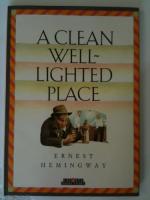|
This section contains 320 words (approx. 1 page at 400 words per page) |

|
A Clean, Well-Lighted Place Summary & Study Guide Description
A Clean, Well-Lighted Place Summary & Study Guide includes comprehensive information and analysis to help you understand the book. This study guide contains the following sections:
This detailed literature summary also contains Bibliography on A Clean, Well-Lighted Place by Ernest Hemingway.
Many of the 1933 short stories which make up the collection Winner Take Nothing were published just before the book. "A Clean, Well-Lighted Place" is one of these. Its publication in collected form only succeeded by months its initial publication in Scribner's Magazine, a magazine, not uncoincidently, belonging to the titular publisher who first printed most of Ernest Hemingway's major fiction (including this collection).
By 1933, Hemingway was an established writer and this exceptional minimalist short story was seized upon for its presentation of major authorial concerns in an unprecedentedly concentrated form. These major authorial preoccupations include good conduct and solidarity. The younger waiter must be judged for his refusal to play by (unspoken) rules that say he must be polite and courteous to the old man. The older waiter, in contrast, upholds these standards by being willing to stay as late as the old man wants him to. The exceptionality of the piece made it an obvious choice for critics. Critics used the story either to laud or condemn Hemingway on the basis of their judgment of these minimalist aesthetics and these ethical concerns.
For supporters of Hemingway's talent, the story's emotional and philosophical austerity and bleakness amounts to profound and true tragedy. For detractors of Hemingway, it is Hemingway as a parody of himself, in which a purported thematics of stoic endurance only poorly covers an underlying self-indulgent masochism. This masochism, his detractors argue, blinds Hemingway to the variety and complexity of life. Stories in which little happens but extremes of simplicity interrupted by the highest drama do not resemble life, these critics insist. In defense of Hemingway, admirers argue that his stories are not meant to compete with fiction that presents life just as it is lived. The story's admirers argue that "A Clean, Well-Lighted Place" is Hemingway at his most pure because he captures in both form and content an irreducible and tragic essence of life.
Read more from the Study Guide
|
This section contains 320 words (approx. 1 page at 400 words per page) |

|



